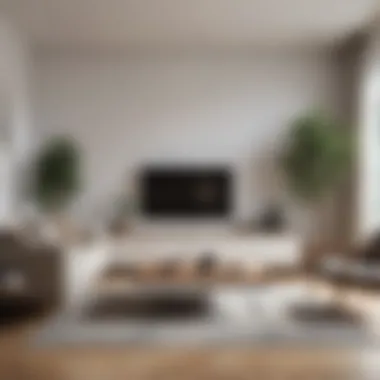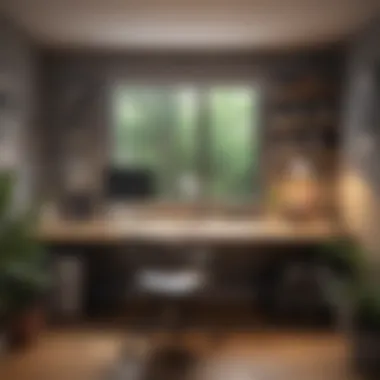Mastering Home Decluttering: Effective Strategies


Intro
Decluttering your home can feel daunting, but it is essential for creating a harmonious living environment. Many people underestimate the psychological burden that clutter imposes on our daily lives. Living among excess belongings can lead to feelings of stress, frustration, and overwhelm. It may be surprising, but the spaces we inhabit can greatly influence our mental peace and productivity.
The journey of decluttering extends beyond the act of simply removing items. It is about cultivating a lifestyle that prioritizes simplicity and functionality. A structured approach can streamline your possessions and contribute to a minimalist aesthetic that many find calming and inspiring. Every item in your space should serve a purpose or bring you joy.
In this guide, we outline various decluttering techniques, discuss the profound impact of organization on your environment, and explore the long-term benefits of minimalism. With practical insights tailored for both homeowners and renters, we aim to help you create a more functional living space through effective strategies.
Understanding Clutter and Its Impact
Understanding clutter is crucial in any decluttering process. Clutter refers not only to physical items cluttering a space but also to the psychological weight it carries. It is more than just a messy room; clutter impacts how we think, feel, and act daily. By understanding the nature and implications of clutter, individuals can initiate meaningful change in their surroundings and lives.
Defining Clutter
Clutter encompasses physical items that accumulate in spaces, often beyond their intended use. It can be anything from unused kitchen gadgets to clothes that have not been worn in months. More than the mere presence of objects, clutter is defined by how these objects function in our lives. Items become clutter when they no longer serve a clear purpose, causing us to navigate around them rather than with them.
The variety of clutter includes:
- Functional clutter: Items that are useful but are not organized or stored correctly.
- Emotional clutter: Objects tied to personal memories that may no longer hold value but are hard to discard.
- Digital clutter: Unused apps, files, and images on electronic devices, which can bombard the mind with excess information.
Recognizing these forms helps tailor the decluttering process to the specific types of clutter present.
Psychological Effects of Clutter
Clutter has profound psychological effects on individuals. Research indicates that excessive clutter correlates with increased anxiety, stress, and an overwhelming sense of chaos. When spaces are cluttered, the brain processes visual information less efficiently, leading to feelings of distraction and reduced productivity. A cluttered environment may also lead to decision fatigue, where the number of choices becomes paralyzing, resulting in avoidance or procrastination.
Furthermore, living amidst clutter can zap mental energy. It can create a sense of unease, impacting mood negatively and leading to feelings of guilt for not managing one’s space effectively. Clearing clutter is often associated with mental clarity, allowing for better focus and improved emotional health.
Assessing the Need to Declutter
Assessing the need to declutter is an essential preliminary step. This assessment begins with an honest evaluation of the current state of your space. Consider the following:
- Identify clutter zones: Walk through your home and note areas that feel congested.
- Reflect on usage: Think about the items you frequently use versus those that are seldom touched.
- Evaluate emotional attachment: Understand which items evoke strong feelings, making them harder to part with.
By analyzing these factors, individuals can prioritize which areas require immediate attention and select appropriate methods for decluttering. Taking time to assess creates a tailored roadmap for the upcoming decluttering journey.
Preparing for the Declutter Process
Preparing for the decluttering process is a fundamental step that ensures a more efficient and focused approach to organizing your living space. Often, individuals dive into decluttering without a clear strategy, leading to frustration and incomplete tasks. By preparing adequately, you're establishing a framework that promotes success. It sets the tone for the entire process, aligning your mindset with the goals you aim to achieve.
Several benefits arise from proper preparation. First, it brings clarity to your objectives. Knowing what you wish to accomplish can save time and guide your actions. Second, by assessing your space and identifying specific problem areas, you can tailor your approach to suit your needs. Lastly, getting prepared helps reduce the risk of feeling overwhelmed, which tends to be a significant barrier to effective decluttering.
Setting Clear Goals
Setting clear goals is essential when embarking on the decluttering journey. The significance of clarity cannot be understated; it gives you direction and purpose. Goals should be specific, measurable, achievable, relevant, and time-bound; a method often referred to as SMART goals.
When considering your goals, think about how you want your space to look and feel. For instance, you could aim for a more open living room or a functional kitchen free from clutter. Write down these goals and display them prominently. This visibility will keep you motivated throughout the process.
Creating a Decluttering Schedule
Establishing a decluttering schedule is critical in maintaining momentum. Setting aside dedicated time slots allows you to focus your efforts without distractions. Regular short sessions can often be more productive than marathon decluttering events. It also helps in creating a habit of decluttering.
To create a schedule, consider your daily routine and commitments. Block off time based upon your availability; even just 15 minutes a day can lead to significant changes. Furthermore, if you are targeting specific rooms, outline a timeline for each area.
Gathering Necessary Supplies
Before you dive into the physical task of decluttering, gather the necessary supplies. Having your tools at hand can streamline the process and keep you organized. For example, ensure you have boxes or bins for sorting items into groups such as Keep, Donate, Discard, and Another Location.


Additionally, consider having cleaning supplies available. Dusting surfaces and vacuuming as you clear out items will create a pleasant environment. You might also want labels or markers handy for clearly identifying boxes, which aids in maintaining organization.
"Preparation is the key to success. Without it, even the best intentions can lead to chaos."
By taking the time to prepare, you're not only setting the stage for a successful decluttering process but also fostering a more organized and functional living space.
Decluttering Techniques to Implement
The process of decluttering is as much about mindset as it is about physical space. Implementing effective techniques can help transform a cluttered environment into a serene oasis. Each technique offers unique advantages and also requires consideration of different personal habits and living situations. Understanding these methods aids in customizing a decluttering strategy that aligns with individual lifestyles.
The Four-Box Method
Keep
The Keep category is essential for identifying what items truly provide value in your life. This portion emphasizes careful consideration, ensuring that only the items that enhance your daily living are retained. A key characteristic of this category is its focus on emotional attachment and utility.
Why it’s beneficial: Keeping items that genuinely matter fosters a sense of fulfillment and purpose in your space. It prevents the accumulation of unnecessary possessions, thus allowing your home to reflect your current needs.
Unique feature: This approach encourages one to assess utility over sentiment at times, which can be a refreshing perspective. However, it may lead to reluctance in parting with cherished items, complicating the decluttering process.
Donate
The Donate box allows individuals to pass on items that are no longer needed but can benefit others. This technique embraces altruism and sustainability. Items that still hold value but do not fit the current lifestyle should be directed to charitable organizations or community groups.
Key characteristic: This method can be very rewarding emotionally as it offers a sense of contribution and community engagement. It also promotes recycling resources, reducing waste in landfills.
Advantages: Donating can lighten your load and create an environment of generosity. On the downside, it can sometimes feel like an overwhelming task to determine which organizations are appropriate for certain types of items.
Discard
The Discard category is straightforward but often necessary. It encompasses items that are broken, outdated, or no longer usable. Recognizing when to discard objects clears mental space and reduces physical clutter significantly.
Key characteristic: The emphasis here is on functionality. If an item serves no purpose anymore, it must be let go. The decision to discard can be liberating.
Unique aspect: While discarding allows for immediate results, it can bring about feelings of guilt if items are perceived as wasteful. Careful deliberation about the future of an item often weighs heavily on the decluttering mind.
Another Location
The Another Location box is for items that do not currently fit within your home but may be needed at a later time. This approach allows for temporary retention of items without cluttering your living space.
Key characteristic: It serves as a transitional option for belongings that require further assessment or that have seasonal use. Utilizing this option carefully can help keep living areas manageable.
Unique feature: This allows you to maintain essential items while creating a less congested environment. Be cautious, however, as this can easily lead to excessive storage and prolong the decluttering process indefinitely.
The Marie Kondo Approach
Marie Kondo’s technique centers on the principle of sparking joy. This approach asks individuals to engage with each item personally, determining whether it resonates positively within their lives. The process encourages a holistic review of possessions, leading to a heightened sense of appreciation for what is kept.
Each item you own should enhance your life in a meaningful way rather than simply occupying space. This technique not only streamlines possessions but also fosters a sense of connection to one’s belongings, allowing individuals to retain meaningful items while discarding the rest.
The / Rule
The 90/90 Rule presents a practical guideline surrounding the utility of items. If you have not used an item in the past 90 days, and do not plan to use it in the next 90 days, it is time to consider letting it go. This straightforward method helps in evaluating your belongings more objectively and minimizing future clutter.
This rule cuts through emotional attachments, allowing for a clear-cut decision-making process. Items that linger without purpose contribute to disorganization and can occupy valuable space.
One-in, One-out Policy


The One-in, One-out Policy is a straightforward concept that promotes balance. When you add a new item to your home, you must remove an existing one. This strategy helps maintain a manageable level of belongings and encourages mindful purchasing.
This practice can safeguard against the creeping nature of clutter. When items are brought in consciously, it reinforces the notion of valuing what you already own, thus creating an intention in the approach to ownership.
Room-by-Room Decluttering Strategy
A room-by-room decluttering strategy is essential for a systematic approach to organizing your living space. This method allows you to focus on one area at a time, making the task less overwhelming. When you declutter room by room, you can better assess what items are essential and what can be removed. This targeted approach not only reduces the clutter but also helps in reevaluating your overall living situation. Each room serves a specific purpose in your home, and creating a designated space for necessary items enhances functionality and improves the quality of life.
Decluttering the Living Room
The living room is often the central hub for family gatherings and social interaction. It should be welcoming and comfortable. Begin by removing items that do not belong. Ask yourself if each item serves a purpose or brings you joy. Consider also the furniture layout. Is it conducive to conversation and relaxation? Ensure that pathways are clear to increase flow. Remember, a clean living room creates a positive first impression when guests arrive.
Organizing the Kitchen
The kitchen is a high-traffic area where organization is crucial. Start with counters; clear off unnecessary appliances and utensils. Categorizing items can help rationalize space effectively. Keep pots and pans near the stove, while food items should be stored in easy-to-reach cabinets. Closing gaps in organization reduces the likelihood of clutter accumulating again. Regularly assess pantry items for expiry dates and freshness.
Streamlining the Bedroom
Creating a serene environment in the bedroom is vital for relaxation and sleep. Start by sorting through clothing. Donate or discard items that you haven't worn in the last year. Consider investing in under-bed storage for seasonal items. Nightstands should only hold essentials like a lamp and a book, maintaining the calm of the space. Establish a routine to tidy up daily; this preserves the tranquility of your personal sanctuary.
Reorganizing the Bathroom
Bathrooms accumulate clutter quickly, from products to towels. Begin by discarding expired or unused items. Keep countertops clear to establish a more spacious feel. Organize toiletries in baskets or drawer dividers. This not only maximizes storage but also enhances accessibility. A well-organized bathroom makes morning and evening routines much smoother.
Optimizing Storage in the Garage
The garage often becomes a catch-all space, making it challenging to find tools and supplies. Start by categorizing items into groups, such as gardening tools, sports equipment, and seasonal decorations. Wall-mounted shelves or pegboards can greatly increase storage efficiency. Ensure frequently used items are easily accessible, as this helps to maintain organization. Establishing a clean garage creates a functional workspace that is both practical and inviting.
"Decluttering is the art of simplicity. Each room tells a story, and a clear narrative begins with a clutter-free space."
Organizing your home room by room not only enhances clarity but also brings a sense of control over your environment. It leads to actionable habits that contribute to an enduring state of order.
Maintaining a Clutter-Free Environment
Maintaining a clutter-free environment is crucial for enhancing both the aesthetics and functionality of a home. Clutter can lead to a sense of chaos, making it difficult to focus or relax in your own space. An organized living area promotes peace of mind and allows for better productivity. The benefits stretch beyond just visual appeal. A clutter-free home can positively influence mental health and create a more welcoming atmosphere for guests.
Daily Habits to Prevent Clutter
Establishing daily habits is one of the most effective ways to prevent clutter from accumulating. Small, consistent actions can significantly change the clutter landscape in your home. For example:
- Make your bed every morning: This simple task can set a positive tone for the day, encouraging you to keep other areas tidy.
- Put things back in their place: After using an item, return it to where it belongs. This can save time and reduce the number of missed items left lying around.
- Limit incoming items: Be selective about what you bring into your home. For instance, consider whether you really need a new decoration or another piece of clothing.
These daily habits create a proactive approach to maintaining a clean environment and can help outsmart eventual chaos.
Establishing Organizational Systems
An essential part of sustaining a clutter-free lifestyle is establishing organizational systems. These systems could include:
- Designating specific places for essentials: Each item should have a designated home. This makes retrieval quick and minimizes the chance of misplacing things.
- Using storage solutions: Invest in clear bins, drawer dividers, or labels to categorize items. For example, a labeled box for seasonal decorations can simplify access throughout the year.
- Creating a digital organization strategy: Digitizing documents can reduce paper clutter. Scanning important paperwork and saving them in folders on your computer or cloud service can save space.
By implementing these organizational systems, you are reinforcing a culture of tidiness in your environment.
Regular Review and Assessment
Regularly reviewing your possessions is a key step in maintaining a clutter-free space. This practice helps you stay mindful of what you own and what you truly need. Schedule:
- Monthly checks of your belongings: Go through closets, drawers, and shelves to see what is no longer being used.
- A seasonal declutter day: Choose a day each season to assess items that may need to be donated or discarded.
- An annual review of organizational systems: Evaluate how well your systems are working. Adjust if certain solutions are not functioning as intended.


Taking time to reassess possessions creates a fluid environment that adapts to your needs. As a result, it cultivates a habit of letting go of excess and embracing simplicity.
"A place for everything, and everything in its place."
Maintaining a clutter-free environment is not a one-time effort, but a continuous practice. By integrating daily habits, establishing effective organizational systems, and conducting regular reviews, you can create a home that stays welcoming, functional, and clear of clutter.
The Role of Minimalism in Decluttering
Minimalism plays a significant role in the decluttering process. It serves as a guiding principle that helps individuals reevaluate their possessions and prioritize what truly matters in their lives. Embracing minimalism is not merely about owning fewer items; it is about fostering a mindset that values quality over quantity. This mindset shift can lead to a more meaningful living environment.
In this article, we will explore minimalism's relevance to decluttering and highlight key strategies that can be utilized. By understanding minimalism, readers can glean insights into how this philosophy can simplify their personal spaces. It promotes intentional living, allowing individuals to focus on what is essential and eliminate distractions caused by excessive items.
Exploring Minimalism
Minimalism encourages individuals to reflect on their living conditions. It urges people to consider whether each item they possess adds value to their lives. This philosophy is not just limited to physical belongings; it extends to thoughts, commitments, and activities that clutter our mental space as well. The challenge lies in recognizing what genuinely serves one's purpose.
Adopting minimalism involves a few key considerations:
- Assessing emotional attachments to items
- Determining the usefulness of possessions
- Understanding the difference between needs and wants
As you begin this exploration, you might find yourself asking whether each object you own contributes positively to your life. This evaluation process can be enlightening and is crucial for effective decluttering.
Benefits of Adopting a Minimalist Lifestyle
There are numerous benefits associated with embracing a minimalist lifestyle. Here are a few notable ones:
- Reduction of Stress: A cluttered environment can lead to feelings of overwhelm. Minimalism combats this by creating open, organized spaces that promote tranquility.
- Improved Focus: Fewer distractions allow for better concentration. This is particularly beneficial for those working from home or managing busy households.
- Financial Savings: When adhering to minimalism, individuals tend to make more intentional purchases. This, in turn, can lead to significant financial savings over time, as the focus shifts from acquiring to appreciating.
- Sustainability: A minimalist approach often means fewer items are purchased, which can contribute to a more sustainable lifestyle. This eco-conscious mindset is increasingly relevant in today’s climate.
Adopting minimalism requires an ongoing commitment to evaluate one’s possessions and preferences. It might be challenging initially, but over time, it fosters a lifestyle enriched by intentional choices.
"Minimalism is not a lack of something. It’s simply the perfect amount of something."
— Nicolette E. Stearns
Resources for Ongoing Decluttering
Continuing the journey of decluttering requires regular effort and support. Relying on ongoing resources can help maintain your efforts and keep your space organized. It is crucial to recognize that decluttering is not a one-time task; rather, it is a lifestyle change. Utilizing various resources available can make this journey smoother and more achievable.
Recommended Books on Decluttering
Books can serve as a powerful tool in understanding the philosophy behind decluttering. Some notable titles include:
- "The Life-Changing Magic of Tidying Up" by Marie Kondo: This book introduces the KonMari method, emphasizing keeping only what sparks joy.
- "Decluttering at the Speed of Life" by Dana K. White: White’s approach focuses on practical solutions for busy lives. She provides actionable strategies for making quick decisions.
- "The Minimalist Home" by Joshua Becker: Becker's work combines minimalism with practical decluttering techniques, perfect for creating a serene living space.
These books offer insights, motivation, and frameworks for decluttering that can be invaluable for individuals at any stage of their journey.
Useful Apps for Organization
In today’s digital age, harnessing technology can enhance your decluttering efforts. Here are some apps that can assist in organizing your home:
- Sortly: This app allows you to create a visual inventory of belongings and organize them effectively.
- Clutterfree: Designed for those looking to reduce clutter, it encourages tracking donations and sales.
- Todoist: While not solely for decluttering, this task management tool helps set goals and keep track of your organizing tasks.
The integration of these applications into daily routines can streamline your organization process, making it easier to keep track of your possessions.
Community Groups and Workshops
Engaging with community organizations can provide motivation and support. Many cities host local decluttering or minimalism groups. Participating in workshops can enhance your understanding of decluttering principles. Look for:
- Local Meetups: Websites like Meetup.com often feature groups focused on decluttering or minimalism.
- Workshops on Minimalism: These workshops typically provide hands-on experience and allow sharing of tips and strategies.
- Social Media Support Groups: Platforms such as Facebook or Reddit have communities dedicated to decluttering discussions and resources.
Joining these communities can offer valuable insights and encouragement, making the decluttering process less solitary and more collaborative.
Remember, the act of decluttering is not merely about getting rid of things; it is a path to clarity and a more meaningful life.
Utilizing these resources ensures your decluttering efforts are sustainable and effective long-term. These tools, whether through literature, technology, or community support, fortify your decluttering journey.



